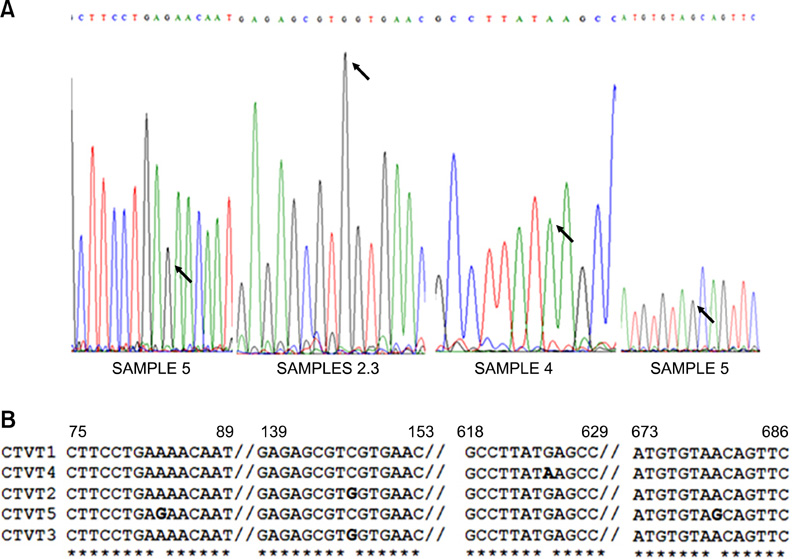J Vet Sci.
2009 Dec;10(4):353-355. 10.4142/jvs.2009.10.4.353.
TP53 Polymorphisms allow for genetic sub-grouping of the canine transmissible venereal tumor
- Affiliations
-
- 1Centro de Investigacion y de Estudios Avanzados en Salud Animal, Facultad de Medicina Veterinaria y Zootecnia, Universidad Autonoma del Estado de Mexico, Carretera de cuota Toluca-Atlacomulco, Kilometro 15.5 C.P. 50200, Toluca Edo, Mexico. jsmartinezc@uae
- 2Instituto Nacional de Medicina Genomica, Periferico Sur No. 4124, Torre Zafiro 2, Piso 6 Col. Ex Rancho de Anzaldo,Alvaro Obregon Mexico, D.F. C.P. 01900, Mexico.
- KMID: 1726910
- DOI: http://doi.org/10.4142/jvs.2009.10.4.353
Abstract
- The canine transmissible venereal tumor (CTVT) is found mainly in dogs' sexual organs. Currently, it is widely accepted that all samples of CTVT show similar histopathological characteristics and share common genetic alterations. Despite the common genetic origin of CTVT, mutations in the P53 gene have been reported. In this study, we proposed that tumor samples can be genetically grouped using this gene. The presence of different subgroups of CTVT was determined in Mexican dogs using the TP53 gene sequence in CTVT samples. Four new polymorphisms were found and therefore, the CTVT samples were classified in five subgroups.
Keyword
MeSH Terms
Figure
Reference
-
1. Calvert CA, Leifer CE, MacEwen EG. Vincristine for treatment of transmissible venereal tumor in the dog. J Am Vet Med Assoc. 1982. 181:163–164.2. Choi YK, Kim CJ. Sequence analysis of canine LINE-1 elements and p53 gene in canine transmissible venereal tumor. J Vet Sci. 2002. 3:285–292.
Article3. Foster RA. McGavin MD, Zachary JF, editors. Female and male reproductive system. Pathologic Basis of Veterinary Disease. 2006. 4th ed. St. Louis: Elsevier;1263–1315.4. Liao KW, Lin ZY, Pao HN, Kam SY, Wang FI, Chu RM. Identification of canine transmissible venereal tumor cells using in situ polymerase chain reaction and the stable sequence of the long interspersed nuclear element. J Vet Diagn Invest. 2003. 15:399–406.
Article5. Murgia C, Pritchard JK, Kim SY, Fassati A, Weiss RA. Clonal origin and evolution of a transmissible cancer. Cell. 2006. 126:477–487.
Article6. Oren M. Regulation of the p53 tumor suppressor protein. J Biol Chem. 1999. 274:36031–36034.
Article7. Oduye OO, Ikede BO, Esuruoso GO, Akpokodje JU. Metastatic transmissible venereal tumour in dogs. J Small Anim Pract. 1973. 14:625–637.
Article8. Rebbeck CA, Thomas R, Breen M, Leroi AM, Burt A. Origins and evolution of a transmissible cancer. Evolution. 2009. 63:2340–2349.
Article9. Setoguchi A, Sakai T, Okuda M, Minehata K, Yazawa M, Ishizaka T, Watari T, Nishimura R, Sasaki N, Hasegawa A, Tsujimoto H. Aberrations of the p53 tumor suppressor gene in various tumors in dogs. Am J Vet Res. 2001. 62:433–439.
Article10. Vázquez-Mota N, Simón-Martínez J, Córdova-Alarcon E, Lagunes L, Fajardo R. The T963C mutation of TP53 gene does not participate in the clonal origin of canine TVT. Vet Res Commun. 2008. 32:187–191.
Article11. Veldhoen N, Milner J. Isolation of canine p53 cDNA and detailed characterization of the full length canine p53 protein. Oncogene. 1998. 16:1077–1084.
Article
- Full Text Links
- Actions
-
Cited
- CITED
-
- Close
- Share
- Similar articles
-
- Sequence analysis of canine LINE-1 elements and p53 gene in canine transmissible venereal tumor
- Detection of progressive and regressive phase and LINE-1 retrotransposon in transfected dogs with transmissible venereal tumor during chemotherapy
- Polymorphisms in Apoptosis-Related Genes and TP53 Mutations in Non-Small Cell Lung Cancer
- SNP genetic polymorphisms of MDR-1, CYP1A2 and CYPB11 genes in four canine breeds upon toxicological evaluation
- TP53 Mutation Status in Myelodysplastic Neoplasm and Acute Myeloid Leukemia: Impact of Reclassification Based on the 5th WHO and International Consensus Classification Criteria: A Korean Multicenter Study


